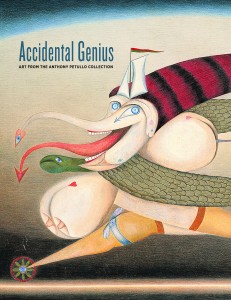Accidental Genius, Art from the Anthony Petullo Collection, by Lisa Stone and Jane Kallir, Milwaukee Art Museum/DelMonico Books/Prestel, 240 pages, 250 color illustrations, 2012. ISBN 978-3-7913-5200-8. Hard cover $60
 Genius is rare enough that it ought to always seem a bit accidental. Genius matched with artistic talent is an even happier coincidence. Artistic genius displayed by art world outsiders is rarer yet. These artists must figure out how to convert their brilliance into powerful acts of creativity on their own, without the support of formal art education and usually with no help at all from outside themselves. While there is a growing canon of established genius in the field, when their ranks are considered against the far greater number of trained artists, or for that matter potential artists in the general population, these geniuses are few indeed.
Genius is rare enough that it ought to always seem a bit accidental. Genius matched with artistic talent is an even happier coincidence. Artistic genius displayed by art world outsiders is rarer yet. These artists must figure out how to convert their brilliance into powerful acts of creativity on their own, without the support of formal art education and usually with no help at all from outside themselves. While there is a growing canon of established genius in the field, when their ranks are considered against the far greater number of trained artists, or for that matter potential artists in the general population, these geniuses are few indeed.
This book pulls together a sample of these exceptional people, using a well-established formula for exhibition catalogs — physical heft; essays by respectable authorities discussing the endlessly debated labeling of the material; lots of pictures of the art; and brief biographies containing oft-repeated information about the artists. This book is an oversize volume. Check. Jane Kaillir, director of Galerie St. Etienne in New York, and Lisa Stone, curator of the Roger Brown Study Collection at the School of The Art Institute of Chicago (and a member of Intuit’s board), both bring long and deep experience with the material. Check. The pictures number in the hundreds. Check. And every artist has a capsule story. Check.
Some key differences distinguish this book from the many vanity collection catalogs that precede it, however. The color plates for featured work are extra large and very sharp. The biographies are in the back of the book, almost as an appendix, meaning that the art, not the stories, is front and center. Kallir is one of the most cogent commenters on term-war issues, while Stone’s comprehension of great art is rarely weighed down by them. The book is also distinguished by thumbnail pictures of every work in the collection donated to the Milwaukee Art Museum by Anthony Petullo. That’s a nice feature for completists. Most important, it is set apart by the distinguished quality of that donation.
Petullo consciously assembled a museum-quality collection for a display just like the exhibit this book documents, and that intention is reflected in the breadth and quality of the work. Not every last piece is as great as the very best pieces in the collection, but there is a preponderance of great artists represented by important pieces. And not only well-known creators. The book includes artists who will be new discoveries even for people quite familiar with the more famous names.
Rosemarie Koczy’s haunting Holocaust drawings, Sylvia Levine’s expressionistic landscapes and portraits, James Lloyd’s pointillist drawings and Josef Karl Radler’s detailed memory paintings are among the less-frequently seen artists in the collection, but big names like Henry Darger, Adolph Wolfli and Bill Traylor are also represented with powerful work, sometimes in depth, as is the case with Scottie Wilson and Carlo Zinelli.
Early in the book Stone references some of the real challenges this art poses in the context of a traditional museum. It’s easy to make the case that the best of self-taught art is the aesthetic equal of what’s already hanging on mainstream walls. But realizing that equality on actual walls with actual work is, as Stone says, not “as straightforward as it would be with a collection of German Expressionist prints or works from some other neatly defined genre.” Art museums are highly analytical places and, as she notes, “Many of these works raise compelling but as yet unanswered questions about their cultural and art historical origins and their purpose, about why they were made and by whom.”
In collections built simply around what the collector likes those tend to be non-issues. It’s relatively easy for collectors to not get bogged down by terms and categories, and Petullo by the account of this book didn’t. But for museums based on art historical analysis and aesthetic distinctions, they do matter. It’s testimony to Petullo’s taste and to the Milwaukee Museum’s ambition that both are up for the challenge of this merger.
This review originally appeared in The Outsider, published by Intuit: The Center for Intuitive and Outsider Art.
